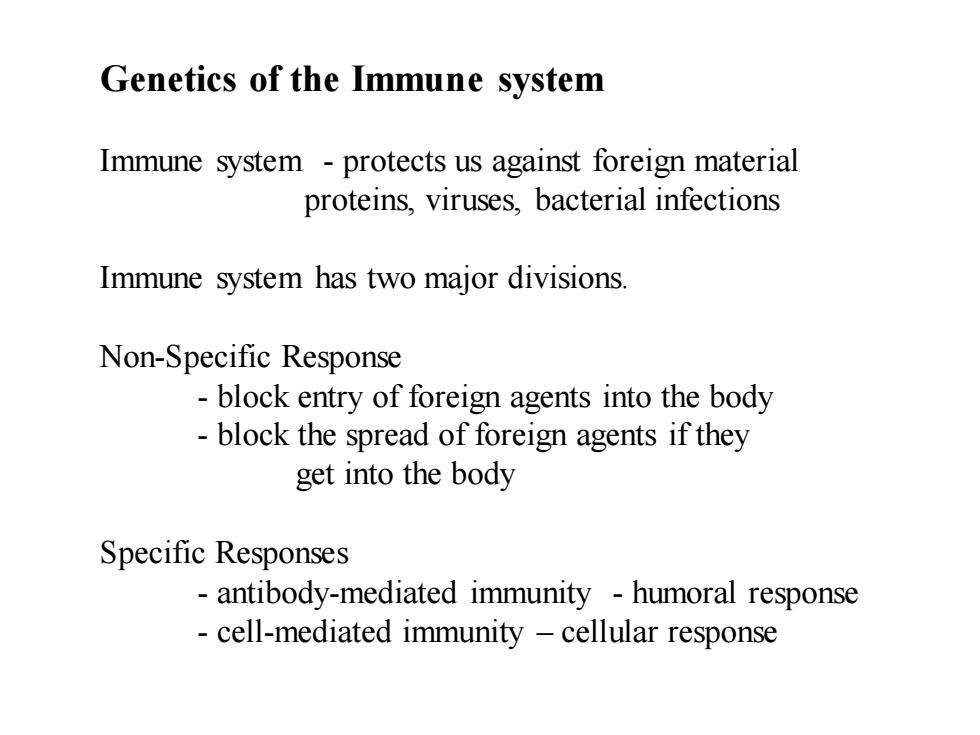
Genetics of the Immune system Immune system -protects us against foreign material proteins,viruses,bacterial infections Immune system has two major divisions. Non-Specific Response block entry of foreign agents into the body block the spread of foreign agents if they get into the body Specific Responses antibody-mediated immunity -humoral response cell-mediated immunity -cellular response
Genetics of the Immune system Immune system - protects us against foreign material proteins, viruses, bacterial infections Immune system has two major divisions. Non-Specific Response - block entry of foreign agents into the body - block the spread of foreign agents if they get into the body Specific Responses - antibody-mediated immunity - humoral response - cell-mediated immunity – cellular response
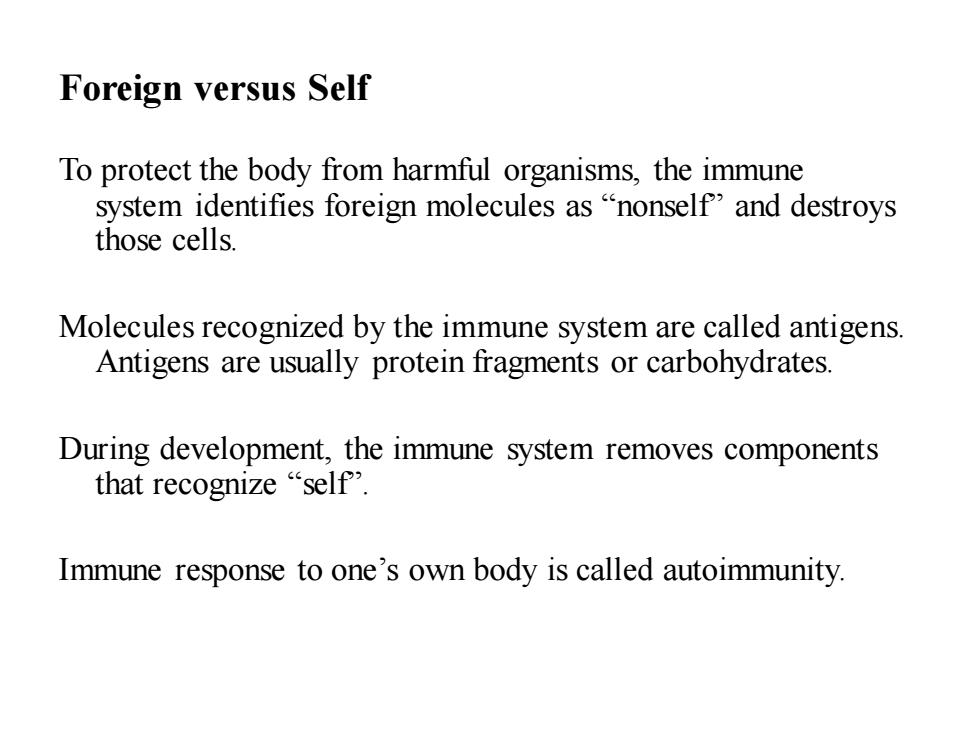
Foreign versus Self To protect the body from harmful organisms,the immune system identifies foreign molecules as "nonself'and destroys those cells. Molecules recognized by the immune system are called antigens. Antigens are usually protein fragments or carbohydrates. During development,the immune system removes components that recognize "self'. Immune response to one's own body is called autoimmunity
Foreign versus Self To protect the body from harmful organisms, the immune system identifies foreign molecules as “nonself” and destroys those cells. Molecules recognized by the immune system are called antigens. Antigens are usually protein fragments or carbohydrates. During development, the immune system removes components that recognize “self”. Immune response to one’s own body is called autoimmunity

1.Physical barriers -skin,mucous membranes and their secretions infection fighting chemicals,in tears,saliva,other body fluids 2.Nonspecific-Innate defenses phagocytosis-(engulfing cells) inflammatory response fever anti-microbial proteins complement,collectins,cytokines 3.Specific response Acquired Immunity -Humoral immune response -B cells,antibodies,memory cells Cellular immune response T cells,cytokines,memory cells
1. Physical barriers - skin, mucous membranes and their secretions - infection fighting chemicals,in tears, saliva, other body fluids 2. Nonspecific - Innate defenses - phagocytosis - (engulfing cells) - inflammatory response - fever - anti-microbial proteins complement, collectins, cytokines 3. Specific response - Acquired Immunity - Humoral immune response - B cells, antibodies, memory cells - Cellular immune response - T cells, cytokines, memory cells

Bacteria Viruses Innate response Physical Cytokines Cilia barriers Antimicrobial secretions Mucous membranes Macrophages Acquired response Macrophages Cellular response present antigens Humoral response T cells B cells Cytokines Memory B cells Cytotoxic T cells Plasma cells Antibodies
Bacteria Viruses Acquired response Mucous membranes Physical barriers Cilia Innate response Cytokines Antimicrobial secretions Macrophages Macrophages present antigens Cellular response T cells Cytokines Cytotoxic T cells Humoral response B cells Memory B cells Plasma cells Antibodies
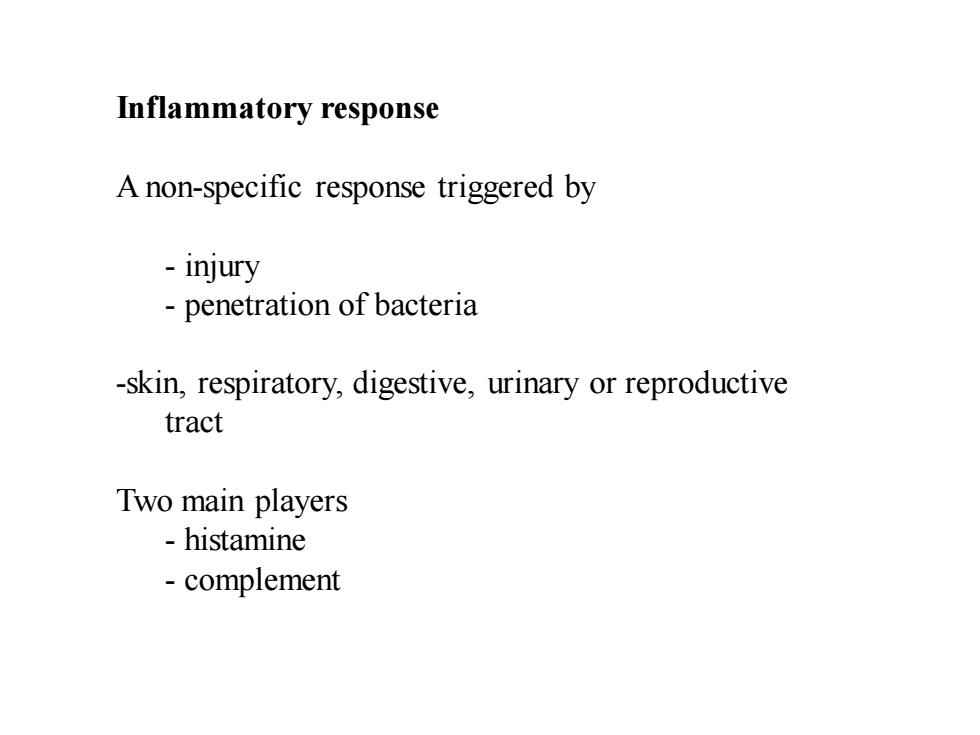
Inflammatory response A non-specific response triggered by injury penetration of bacteria -skin,respiratory,digestive,urinary or reproductive tract Two main players -histamine complement
Inflammatory response A non-specific response triggered by - injury - penetration of bacteria -skin, respiratory, digestive, urinary or reproductive tract Two main players - histamine - complement
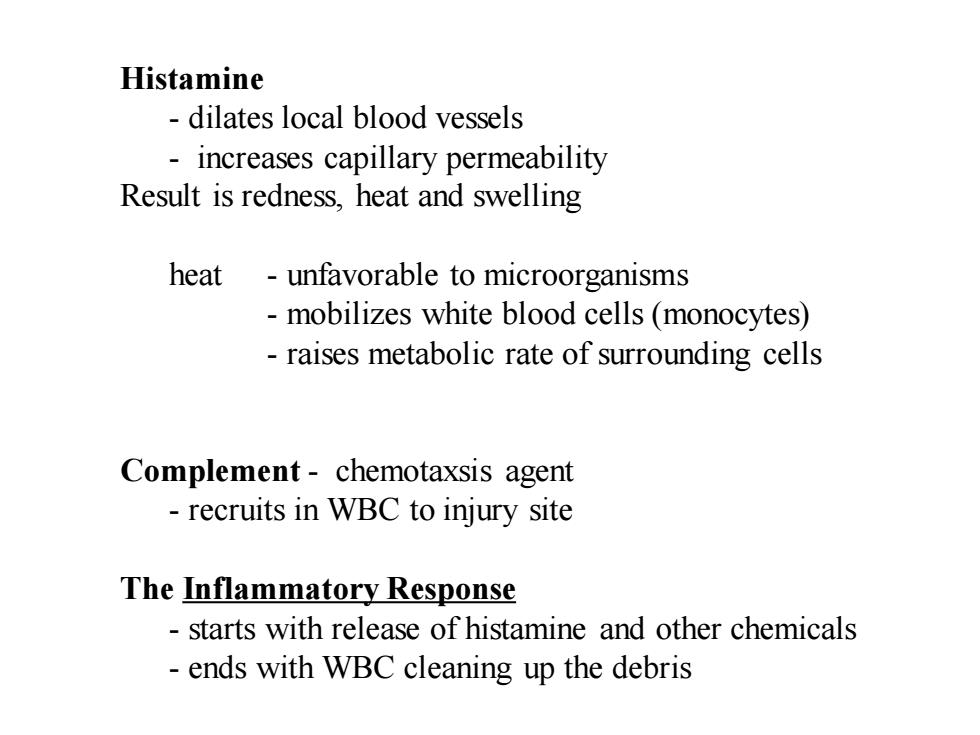
Histamine dilates local blood vessels increases capillary permeability Result is redness,heat and swelling heat unfavorable to microorganisms mobilizes white blood cells(monocytes) raises metabolic rate of surrounding cells Complement-chemotaxsis agent recruits in WBC to injury site The Inflammatory Response starts with release of histamine and other chemicals ends with WBC cleaning up the debris
Histamine - dilates local blood vessels - increases capillary permeability Result is redness, heat and swelling heat - unfavorable to microorganisms - mobilizes white blood cells (monocytes) - raises metabolic rate of surrounding cells Complement - chemotaxsis agent - recruits in WBC to injury site The Inflammatory Response - starts with release of histamine and other chemicals - ends with WBC cleaning up the debris
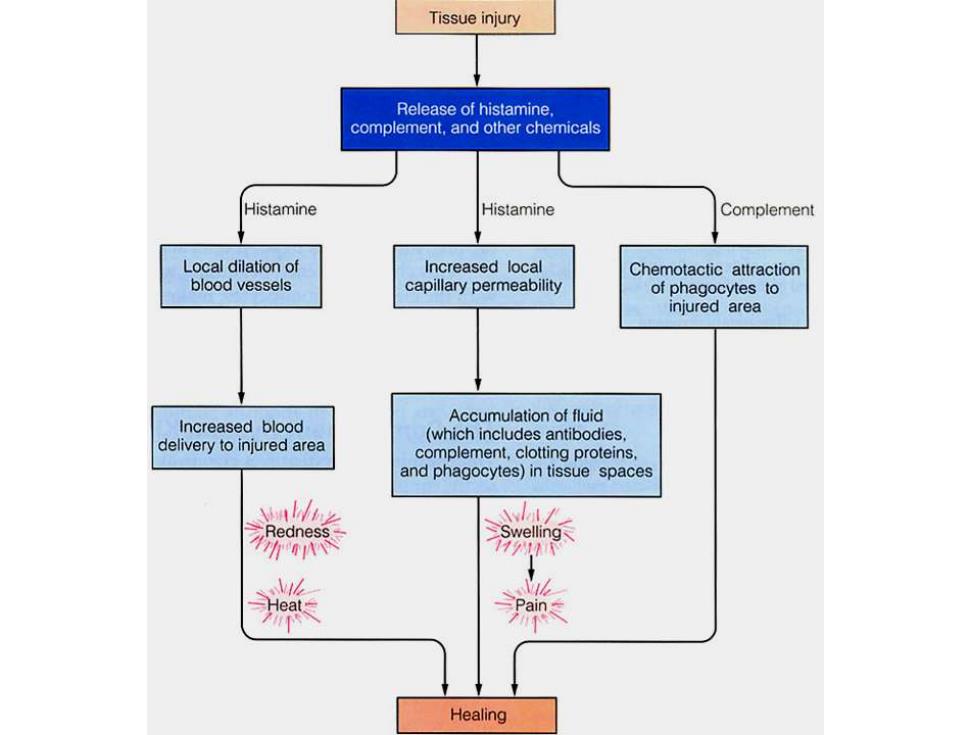
Tissue injury Release of histamine. complement,and other chemicals Histamine Histamine Complement Local dilation of Increased local Chemotactic attraction blood vessels capillary permeability of phagocytes to injured area Increased blood Accumulation of fluid (which includes antibodies. delivery to injured area complement,clotting proteins. and phagocytes)in tissue spaces AL/E乡 Swelling Healing
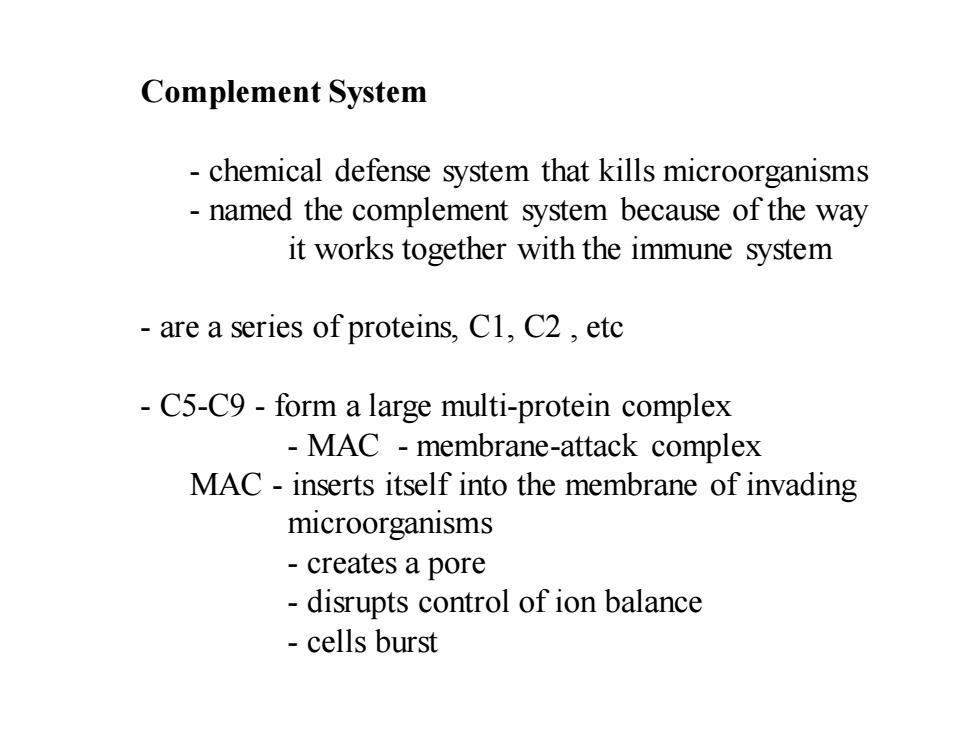
Complement System chemical defense system that kills microorganisms named the complement system because of the way it works together with the immune system are a series of proteins,C1,C2,etc C5-C9-form a large multi-protein complex MAC -membrane-attack complex MAC-inserts itself into the membrane of invading microorganisms creates a pore disrupts control of ion balance cells burst
Complement System - chemical defense system that kills microorganisms - named the complement system because of the way it works together with the immune system - are a series of proteins, C1, C2 , etc - C5-C9 - form a large multi-protein complex - MAC - membrane-attack complex MAC - inserts itself into the membrane of invading microorganisms - creates a pore - disrupts control of ion balance - cells burst
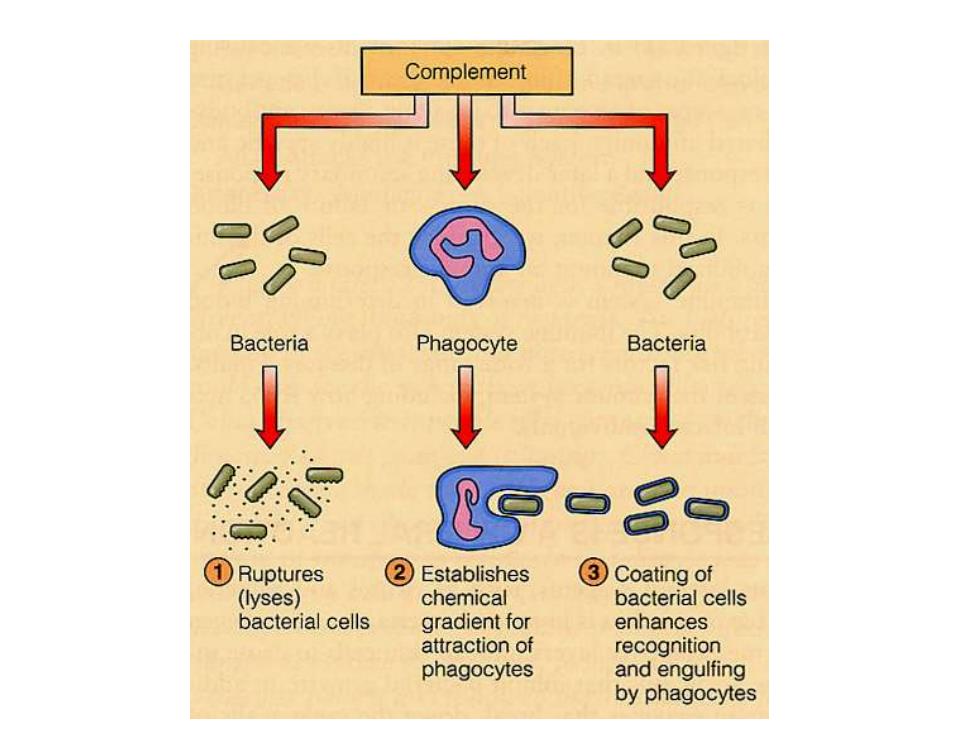
Complement Bacteria Phagocyte Bacteria ①)Ruptures ②Establishes ③Coating of (lyses) chemical bacterial cells bacterial cells gradient for enhances attraction of recognition phagocytes and engulfing by phagocytes
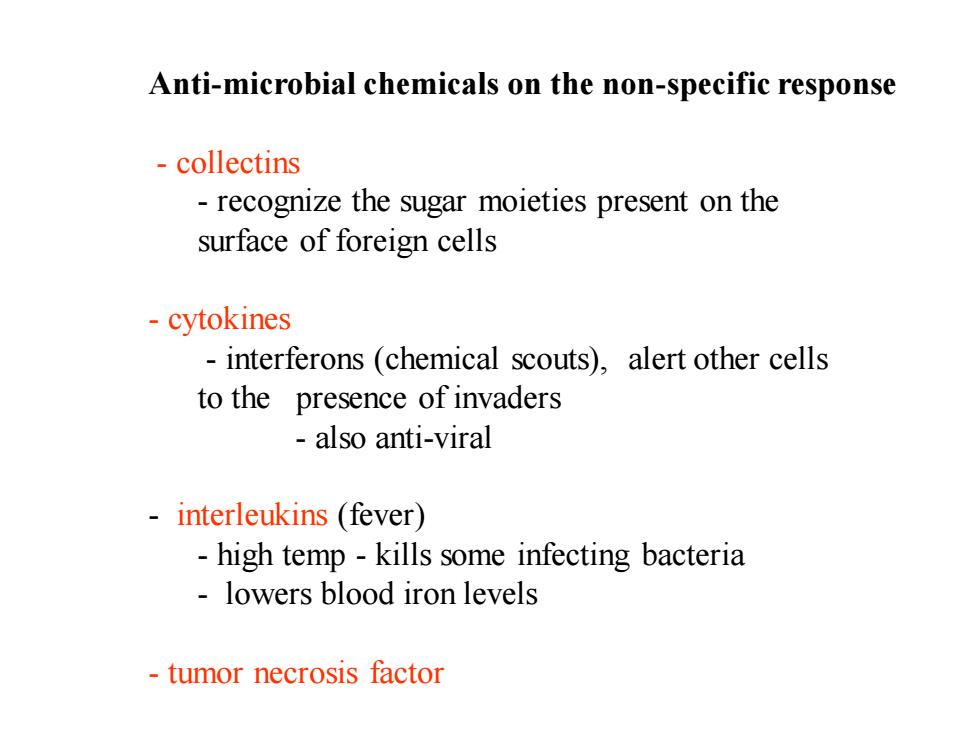
Anti-microbial chemicals on the non-specific response collectins recognize the sugar moieties present on the surface of foreign cells -cytokines interferons (chemical scouts),alert other cells to the presence of invaders also anti-viral interleukins (fever) high temp-kills some infecting bacteria lowers blood iron levels tumor necrosis factor
Anti-microbial chemicals on the non-specific response - collectins - recognize the sugar moieties present on the surface of foreign cells - cytokines - interferons (chemical scouts), alert other cells to the presence of invaders - also anti-viral - interleukins (fever) - high temp - kills some infecting bacteria - lowers blood iron levels - tumor necrosis factor